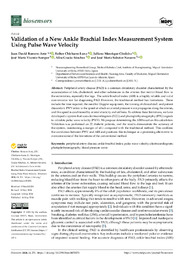Por favor, use este identificador para citar o enlazar este ítem:
https://hdl.handle.net/11000/35010Registro completo de metadatos
| Campo DC | Valor | Lengua/Idioma |
|---|---|---|
| dc.contributor.author | Gracia Sánchez, Alba | - |
| dc.contributor.author | Romero Ante, Juan David | - |
| dc.contributor.author | Chicharro Luna, Esther | - |
| dc.contributor.author | Manrique Cordoba, Juliana | - |
| dc.contributor.author | Vicente Samper, José María | - |
| dc.contributor.author | Sabater-Navarro, Jose Maria | - |
| dc.contributor.other | Departamentos de la UMH::Ciencias del Comportamiento y salud | es_ES |
| dc.date.accessioned | 2025-01-20T10:14:20Z | - |
| dc.date.available | 2025-01-20T10:14:20Z | - |
| dc.date.created | 2024 | - |
| dc.identifier.citation | Biosensors | es_ES |
| dc.identifier.issn | 2079-6374 | - |
| dc.identifier.uri | https://hdl.handle.net/11000/35010 | - |
| dc.description.abstract | Peripheral artery disease (PAD) is a common circulatory disorder characterized by the accumulation of fats, cholesterol, and other substances in the arteries that restrict blood flow to the extremities, especially the legs. The ankle brachial index (ABI) is a highly reliable and valid non-invasive test for diagnosing PAD. However, the traditional method has limitations. These include the time required, the need for Doppler equipment, the training of clinical staff, and patient discomfort. PWV refers to the speed at which an arterial pressure wave propagates along the arteries, and this speed is conditioned by arterial elasticity and stiffness. To address these limitations, we have developed a system that uses electrocardiogram (ECG) and photoplethysmography (PPG) signals to calculate pulse wave velocity (PWV). We propose determining the ABI based on this calculation. Validation was performed on 22 diabetic patients, and the results demonstrate the accuracy of the system, maintaining a margin of ±0.1 compared with the traditional method. This confirms the correlation between PWV and ABI and positions this technique as a promising alternative to overcome some of the limitations of the conventional method. | es_ES |
| dc.format | application/pdf | es_ES |
| dc.format.extent | 19 | es_ES |
| dc.language.iso | eng | es_ES |
| dc.publisher | MDPI | es_ES |
| dc.relation.ispartofseries | 14 | es_ES |
| dc.relation.ispartofseries | 5 | es_ES |
| dc.rights | info:eu-repo/semantics/openAccess | es_ES |
| dc.rights | Attribution-NonCommercial-NoDerivatives 4.0 Internacional | * |
| dc.rights.uri | http://creativecommons.org/licenses/by-nc-nd/4.0/ | * |
| dc.subject | peripheral artery disease | es_ES |
| dc.subject | ankle brachial index | es_ES |
| dc.subject | pulse wave velocity | es_ES |
| dc.subject | electrocardiogram | es_ES |
| dc.subject | photoplethysmography | es_ES |
| dc.subject | blood pressure wave | es_ES |
| dc.subject.other | CDU::6 - Ciencias aplicadas::61 - Medicina | es_ES |
| dc.title | Validation of a New Ankle Brachial Index Measurement System Using Pulse Wave Velocity | es_ES |
| dc.type | info:eu-repo/semantics/article | es_ES |
| dc.relation.publisherversion | https://doi.org/10.3390/bios14050251 | es_ES |

Ver/Abrir:
Validation of a New Ankle Brachial Index Measurement System Using Pulse Wave Velocity.pdf
11,58 MB
Adobe PDF
Compartir:
 La licencia se describe como: Atribución-NonComercial-NoDerivada 4.0 Internacional.
La licencia se describe como: Atribución-NonComercial-NoDerivada 4.0 Internacional.
.png)